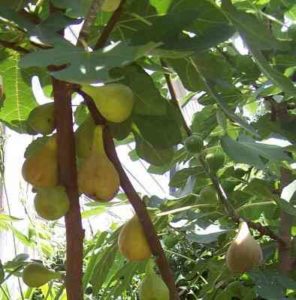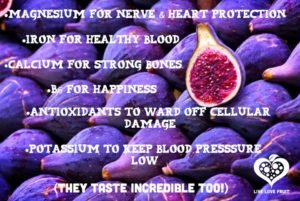
FIGS
Figs provide more fiber than any other common fruit or vegetable. The fiber is both soluble and insoluble and both types of fiber are important for good health.
¼ cup serving = 5 grams fiber, 6% iron, 6% of calcium, and 7% of the Daily Value for potassium.
They have no fat, no sodium, and no cholesterol. They have a high quantity of polyphenol antioxidants. The fruit contains a proteolytic enzyme that is considered an aid to digestion and is used by the pharmaceutical industry. Because of its high alkalinity it has been mentioned as being beneficial to persons wishing to quit smoking. Psoralen, which occurs naturally in figs, some other plants and fungi, is a skin sensitizer that promotes tanning in the sun.
Diets rich in soluble and insoluble fibers, such as figs, help maintain healthy blood cholesterol levels and may lower colon cancer risk.
Although considered a fruit, the fig is actually a flower that is inverted into itself. The seeds are drupes or the real fruit. Figs contain a natural humectant — a chemical that will extend freshness and moistness in baked products. Figs come in colors from yellow, brown, and red to purple, and black!
Figs are easy to pick! Ripe figs droop and feel softer. They separate easily from the tree when lifted upwards from their normal drooping position. Figs must be picked ripe. They do not ripen once picked. Some people are allergic to the milky white latex liquid produced by the fig tree and develop contact rashes.
The complex inflorescence of the common fig consists of a hollow fleshy structure (syconium,) lined with numerous unisexual flowers. The edible fig fruit is the mature syconium on the outside and numerous one-seeded fruits (druplets) on the inside. This type of multiple fruit is sometimes called infructescence.
Figs won’t last long at room temperature, but a mildly cool refrigerator will keep them several days.
Fig varieties include:
Brown Turkey Figs are used exclusively for the fresh fig market and is common at PYO farms..
Celeste figs are about the size of an egg, a purplish-brown when ripe, and a dark, sweet, moist, purple flesh inside.
The Calimyrna Fig is known for its nut-like flavor and golden skin. Commonly eaten as is.
The Mission Fig, named for the mission fathers who planted the fruit along the California coast, is a deep purple and darkens to a rich black when dried.
The Kadota Fig is thick-skinned with a creamy amber color when ripe. Practically seedless, this fig is often canned and dried.


